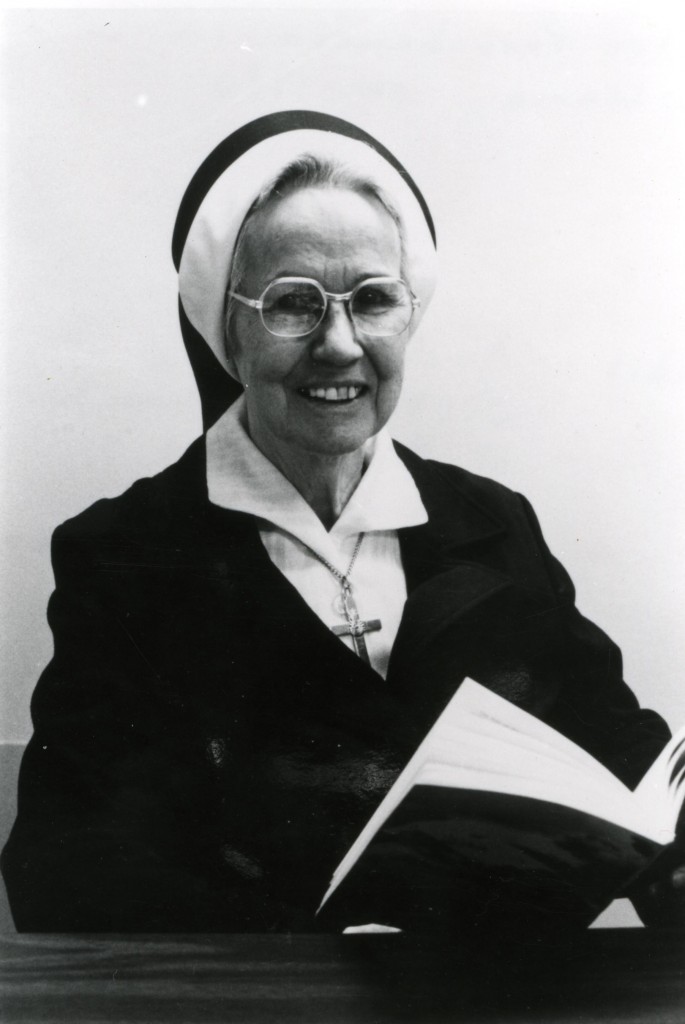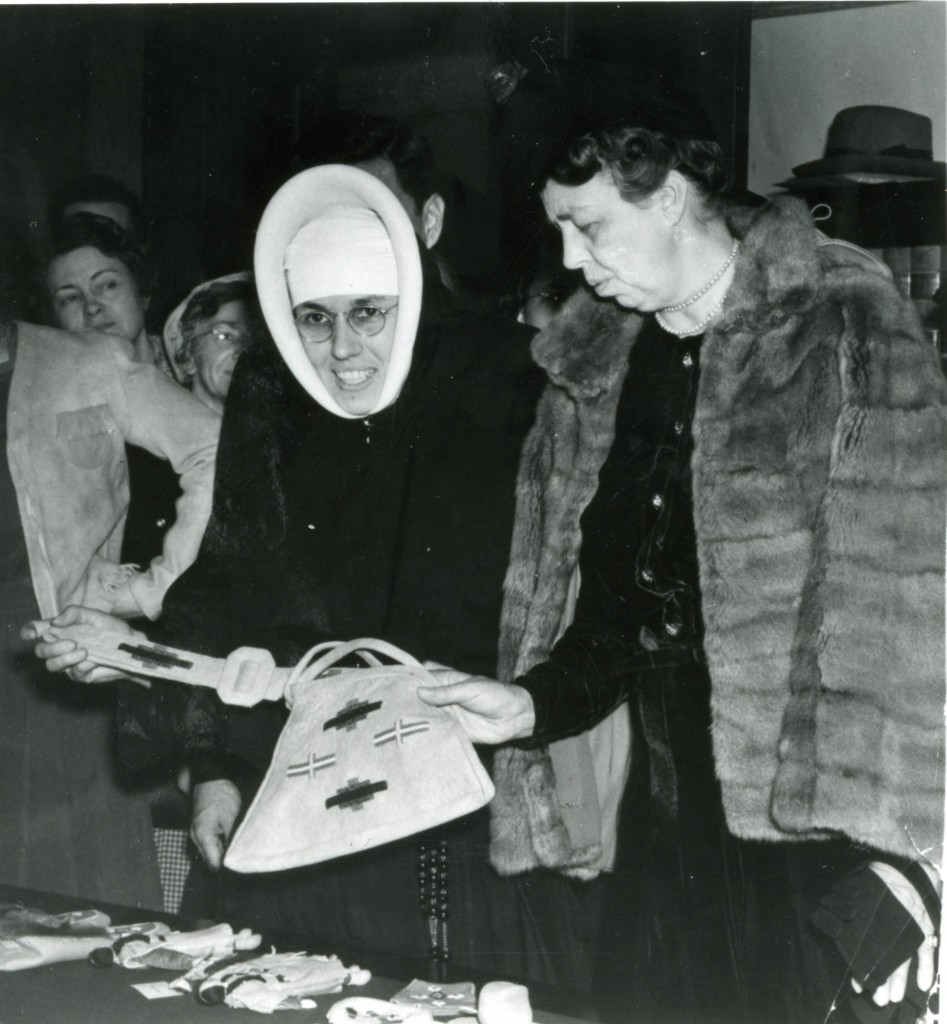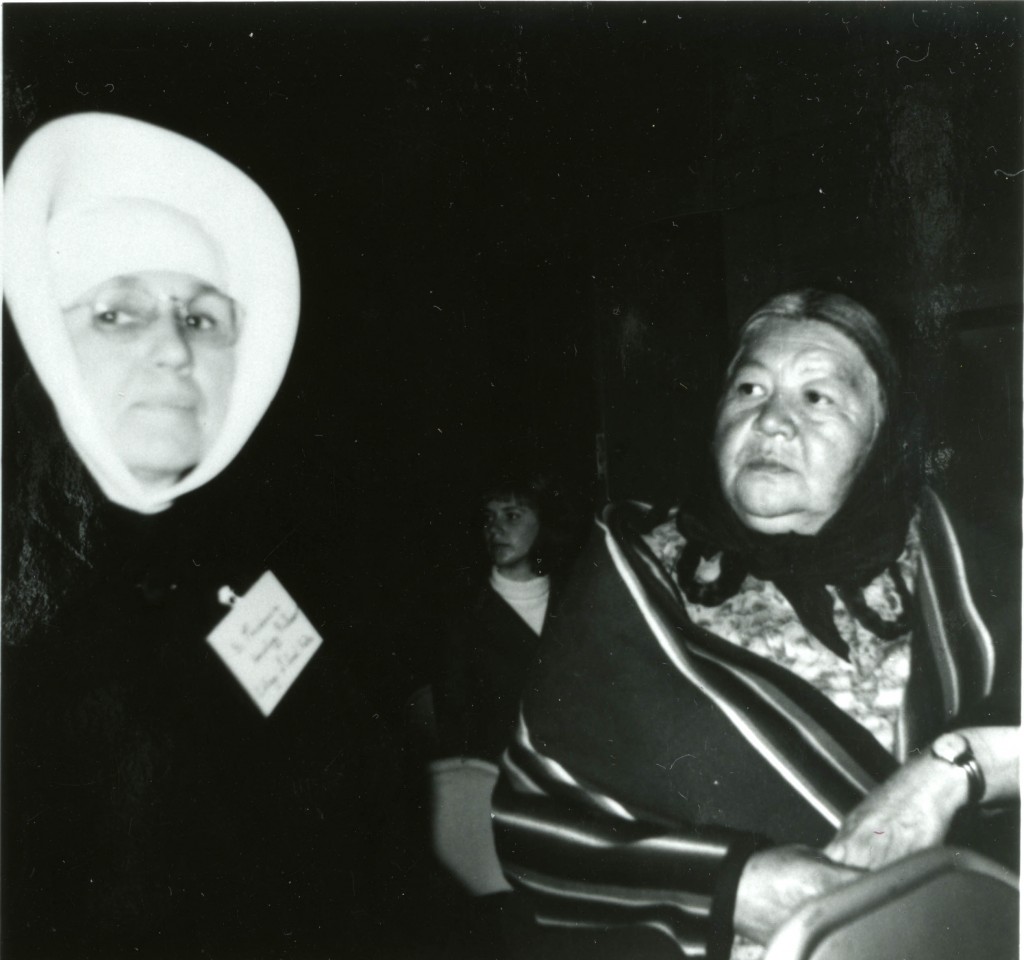
In 1952, a nun teaching sociology at the College of Great Falls committed herself to alleviating poverty among the city’s Indians. What began as an effort to solve a local problem grew into a twenty-year crusade on behalf of all American Indians, taking Sister Providencia Tolan from Great Falls to Congress. In the process, she collaborated with charitable organizations and Indian advocates to change the course of federal Indian policy.
Great Falls’ Indian residents lived primarily in makeshift communities like Hill 57 on the edge of town. Their overcrowded shacks lacked utilities. Many were unskilled, undereducated seasonal laborers who struggled to provide for their families. For years, concerned citizens donated necessities to provide stopgap assistance. While supporting these efforts, Sister Providencia also approached the matter as a sociologist: studying the problem, ascertaining its root causes, and advocating social and political solutions.
One cause of the urban Indians’ plight was the matter of jurisdiction. The federal government denied responsibility for unenrolled, non-recognized, or off-reservation Indians. City, county, and state agencies frequently refused assistance out of the misconception that all Indians were wards of the federal government.
Compounding the jurisdictional conundrum were two federal Indian policies instituted in the 1950s that increased Indian landlessness and poverty: Termination and Relocation. Under Termination, the federal government dissolved its trust responsibilities to certain tribes. Deprived of services and annuities promised them in treaties, terminated tribes liquidated their assets for immediate survival. When the Turtle Mountain Chippewa tribe was terminated in 1953, some families moved to Great Falls to live with their already impoverished relatives on Hill 57. The Relocation policy also moved Indian families to cities without ensuring that they had the means for long-term survival. Meanwhile, the government did not increase aid to states or counties so that they could cope with the expanding numbers of people in need.

“The restricting of Bureau welfare programs and the present hardship situation . . . are cause and consequence,” Sister Providencia concluded. She contended that policies that dismantled tribes also eroded tribal values and broke down Indian families. The nun witnessed this disintegration in Great Falls, where teenage Indian girls became prostitutes to earn money for food and desperate young men committed suicide. Sister Providencia encountered a boy from a Chippewa family who “stood crying at the reception desk of the hospital, his pockets full of leaves. He told me that they were his only food for two days.”
Sister Providencia insisted that Montanans had to “spearhead the drive aimed at reaching a solution” to Indian poverty. She urged local institutions to increase their contributions of goods and services and rallied the press for greater coverage of the issue. Her students conducted comprehensive sociological studies of poverty among Great Falls’ Indian population and then went on the radio to ask why “Uncle Sam should forget his treaty obligations to these Indian people, just because they have been forced to leave their reservations.”
Sister Providencia realized that Indians who were repeatedly denied relief, medical services, and aid believed that white society did not care if they survived, so she worked with the Community Council of Cascade County to hold public forums on Termination and off-reservation Indian poverty. The College of Great Falls and the Friends of Hill 57 sponsored “Workshops in Understanding” to build empathy among non-Indians. Testimony from women who had provided educational assistance, secured donations of food and clothing, and arranged to bring utilities to Hill 57 revealed the severity of the problem and underscored the need for federal involvement.
Sister Providencia found allies in the Montana Intertribal Policy Board (MT-IPB) and Montana’s Advisory Council on Indian Affairs, two groups fighting reservation poverty and Termination. Beginning in 1953, officers of the MT-IPB were elected to the National Congress of American Indians (NCAI)—the most influential Indian policy organization in the country. Sister Providencia became an advisor to both the MT-IPB and the NCAI.
Together, they pressured the government to uphold its obligations. In 1957 Montana’s legislature passed four joint memorials demanding restoration of federal obligation in matters of Indian welfare, education, employment, and health care. Montana’s Sen. James Murray and Rep. Lee Metcalf introduced reform legislation in Congress. Encouraged by Sister Providencia, the Great Falls Business and Professional Women sponsored a woman from Hill 57 to travel to Washington to testify in favor of the proposals.
Despite an abundance of testimony supporting the reforms, the Interior Department blocked their passage. Commissioner of Indian Affairs Glenn Emmons also refused an offer by Great Falls landowners to donate Hill 57 lots for a landless Indian reservation, insisting the Indians should apply for relocation assistance through their reservations—assistance for which non-recognized or terminated Indians were ineligible.

A breakthrough in their efforts came when Sister Providencia invited broadcaster Robert McCormick to visit Hill 57 and provided him with material for a documentary. Broadcast by NBC in November 1958, The American Stranger exposed the government’s neglect of its indigenous citizens. Sister Providencia convinced NBC to make copies of the documentary available for rebroadcast around Montana and elsewhere. Within days, NBC, Metcalf, and the Indian Bureau received thousands of letters from Americans faulting the Interior Department.
Sister Providencia never stopped lobbying. When vice-presidential candidate Lyndon Johnson campaigned in Great Falls in 1959, the nun reminded him of the government’s obligations to American Indians. Johnson agreed that their condition was “a federal responsibility.”
The tide finally turned in the 1960s, when President Johnson launched the War on Poverty. Sister Providencia, the NCAI, and Indian leaders worked closely with Metcalf to ensure War on Poverty programs addressed Indians’ need for educational assistance, welfare, medical services, and job training. Together, they helped end Termination and ushered in Self-Determination policies that restored the nation-to-nation relationship between tribes and the federal government. LKF
Read More about Sister Providencia in Joan Bishop’s article, “From Hill 57 to Capitol Hill: ‘Making the Sparks Fly.’ Sister Providencia Tolan’s Drive on Behalf of Montana’s Off-Reservation Indians, 1950-1970,” published in Montana The Magazine of Western History 43, no. 3: 16-29.
Among Sister Providencia’s allies was Freda Beazley, vice-president of the National Congress of American Indians and an officer on the Montana Intertribal Policy Board (MIPB). Learn more about this Assiniboine anti-poverty activist in Freda Augusta Beazley and the Rise of American Indian Political Power.
Sources
Billings, Gretchen. “American Indian Being Pushed Further into Never-Never Land.” The People’s Voice, August 17, 1956: 2.
Bishop, Joan. “From Hill 57 to Capitol Hill: ‘Making the Sparks Fly.’ Sister Providencia Tolan’s Drive on Behalf of Montana’s Off-Reservation Indians, 1950-1970.” Montana The Magazine of Western History 43, no. 3: 16-29.
Community Council of Cascade County records, 1948-1968. Small Collection 1989, Montana Historical Society, Helena.
Community Council of Cascade County, Vertical File, Montana Historical Society Research Center, Helena.
Deligdish, Andrea. Our Indian Neighbors. A Report to the Great Falls Citizens’ Committee on Indian Affairs. Great Falls: College of Great Falls, 1964.
Lamere, Eunice, and Gertrude Lindgren. “Hill 57 Goes to Washington.” Indian Project Report to Great Falls Business and Professional Women, 1957. Unpublished. Community Council of Cascade County records, Small Collection 1989, Montana Historical Society, Helena.
“Landless Indian Hearing Reveals Need for Action by Congress.” Great Falls Tribune, September 10, 1955, n.p. Sister Providencia, Vertical File, Montana Historical Society Research Center, Helena.
Landless Indians of Montana. Vertical File, Montana Historical Society Research Center, Helena.
“Lions Members Informed . . . Hill 57 Exemplifies Stage of Indian Pride Dying Out.” Great Falls Tribune, December 12, 1956, n.p. Sister Providencia, Vertical File, Montana Historical Society Research Center, Helena.
“Montana Legislative Memorials Stress Indian Neglect.” Great Falls Tribune, March 8, 1957, n.p. Sister Providencia, Vertical File, Montana Historical Society Research Center, Helena.
Sister Providencia [Tolan]. Vertical File, Montana Historical Society Research Center, Helena.
Tolan, Sister Providencia. “Indian Bureau at Fault. Hardships on Reservations Are ‘Cause and Consequence.’” Letter to Frank Murray, Montana Secretary of State. Reprinted in The People’s Voice. April 11, 1958, 1-2.
For the month of September, I decided to commit my facebook page to honoring women of history in Montana and the far West, and while searching for information and photos on women featured in some books and publications that I have, I found this site. I am glad I did, because it is a wonderful project, with excellent information and showcases women who are not in the books, and who I would not have otherwise have known. I plan to feature some of the women who have impacted Montana and share the information with others who visit my page in the little vignettes I am posting daily for this month. Thanks, F annie Bee
Glad you found us. Thanks for helping us spread the word about women’s history. Any links to our site will be appreciated, of course. And, did you know that you can also find us on Facebook? https://www.facebook.com/montanawomenshistory
Thank you. I will be sure to make a connection to your website, too. People need to know about this project. I did not know you were on Facebook and will check out the page. I may be able to share some of it on my Lozeau Lodge fan page. Thanks, F annie Bee